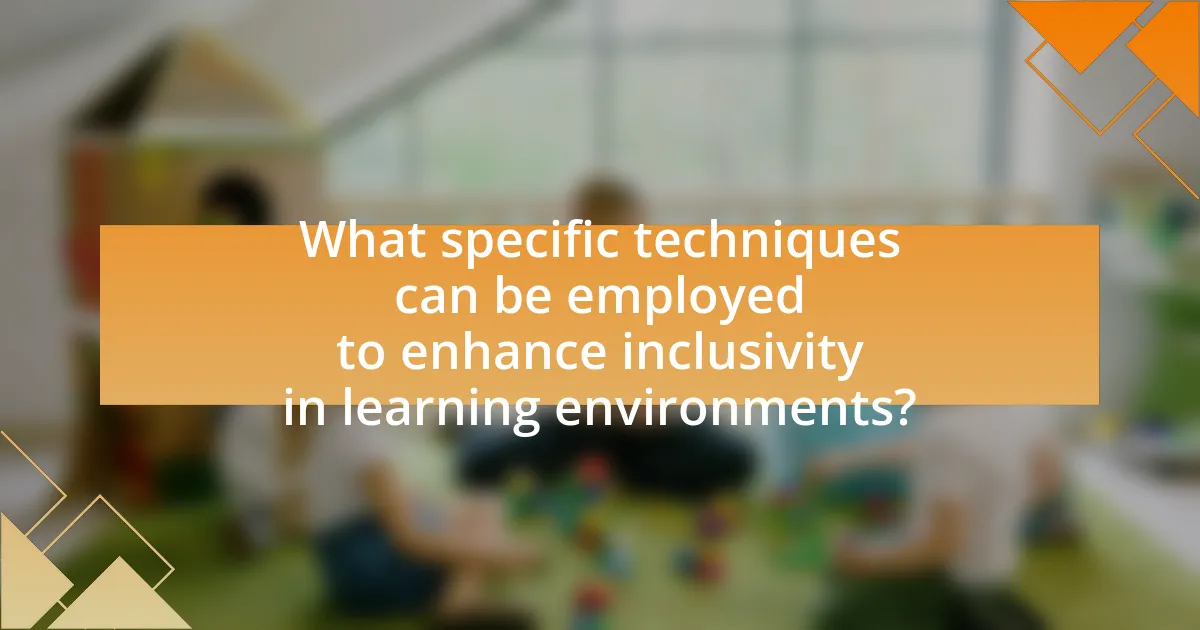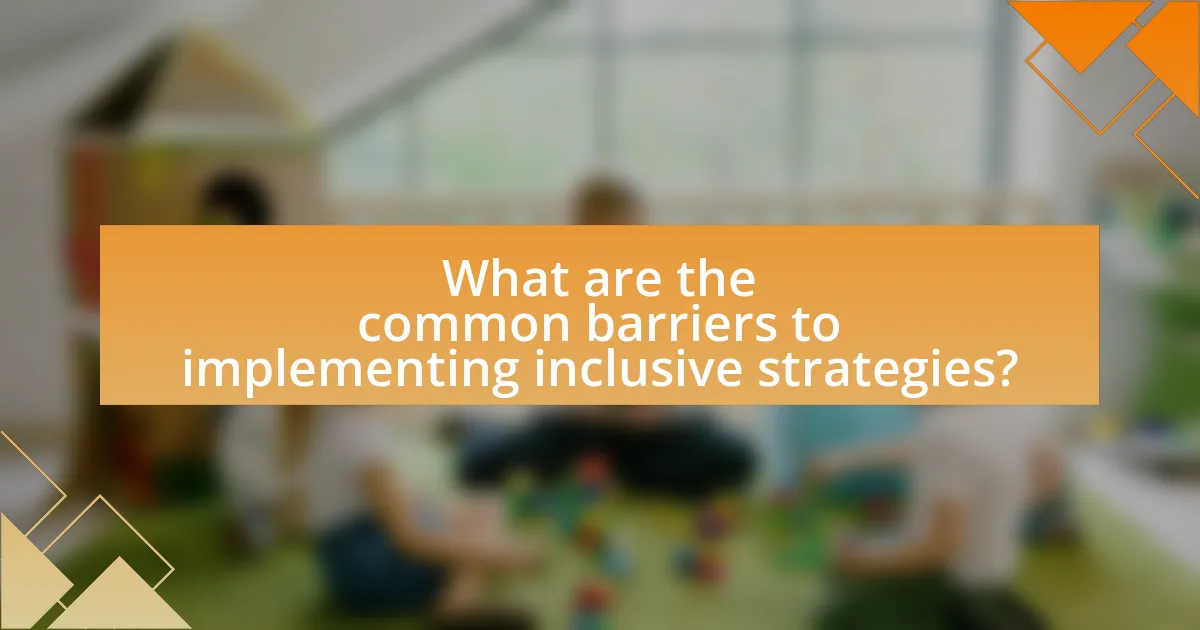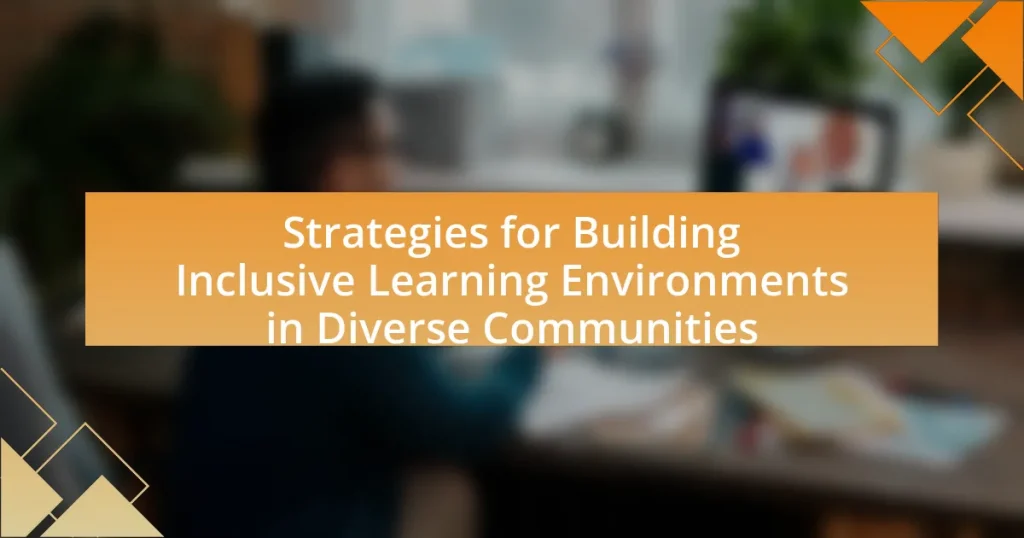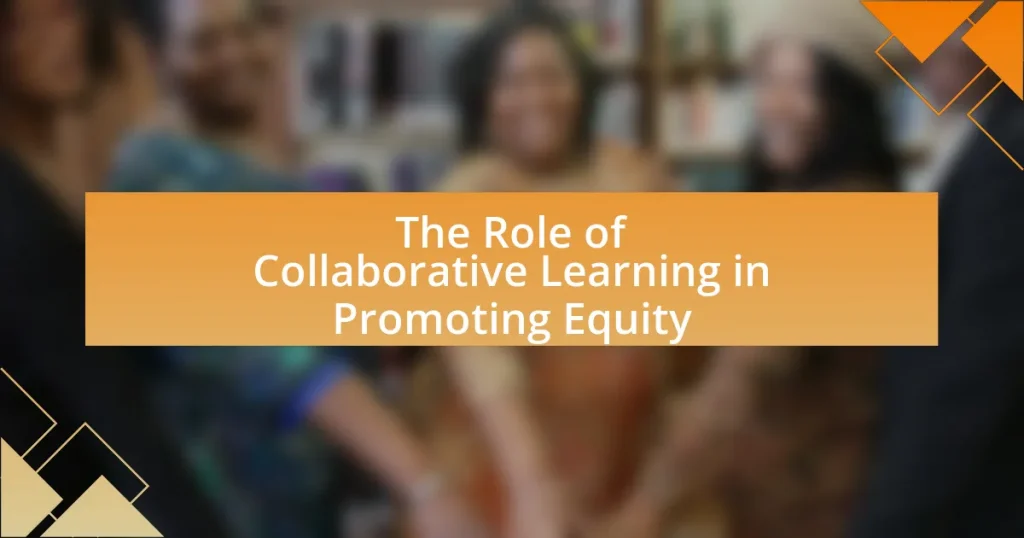The article focuses on strategies for building inclusive learning environments in diverse communities, emphasizing the importance of fostering a culture of respect, implementing differentiated instruction, and promoting collaborative learning. It addresses the unique challenges faced by diverse learners in traditional educational settings, such as language barriers and cultural biases, and highlights the benefits of inclusivity for academic performance and social cohesion. The article also discusses the role of educators in fostering inclusivity, the significance of community engagement, and the resources available to support inclusive practices, ultimately underscoring the need for ongoing training and collaboration to create equitable learning experiences for all students.

What are the key strategies for building inclusive learning environments in diverse communities?
Key strategies for building inclusive learning environments in diverse communities include fostering a culture of respect, implementing differentiated instruction, and promoting collaborative learning. Fostering a culture of respect involves creating an atmosphere where all students feel valued and heard, which can be achieved through community-building activities and open dialogues about diversity. Implementing differentiated instruction allows educators to tailor their teaching methods to accommodate various learning styles and needs, ensuring that every student can engage with the material effectively. Promoting collaborative learning encourages students from different backgrounds to work together, enhancing their social skills and cultural understanding. Research indicates that inclusive practices lead to improved academic outcomes and social cohesion among students in diverse settings.
How do these strategies address the needs of diverse learners?
These strategies address the needs of diverse learners by promoting differentiated instruction, which tailors teaching methods to accommodate various learning styles and abilities. For instance, using visual aids, hands-on activities, and collaborative projects allows educators to engage students with different strengths, ensuring that all learners can access the curriculum effectively. Research indicates that differentiated instruction can lead to improved academic outcomes for diverse student populations, as it fosters an inclusive environment where individual needs are recognized and met.
What specific challenges do diverse learners face in traditional learning environments?
Diverse learners face challenges in traditional learning environments primarily due to a lack of tailored instructional methods. These learners often encounter barriers such as language differences, varying cultural backgrounds, and differing learning styles, which can hinder their academic performance. For instance, research indicates that students from non-English speaking backgrounds may struggle with comprehension and participation, leading to lower engagement levels (National Center for Education Statistics, 2020). Additionally, cultural biases in curriculum and assessment methods can marginalize diverse perspectives, further complicating their educational experience. These challenges highlight the need for inclusive strategies that accommodate the unique needs of all learners.
How can understanding these challenges inform the development of inclusive strategies?
Understanding the challenges faced by diverse communities informs the development of inclusive strategies by highlighting specific barriers to participation and learning. For instance, recognizing that language barriers can hinder communication allows educators to implement multilingual resources and support systems. Additionally, understanding socioeconomic disparities can lead to the creation of targeted financial assistance programs, ensuring equitable access to educational materials and opportunities. Research indicates that inclusive strategies, such as differentiated instruction and culturally responsive teaching, significantly improve engagement and learning outcomes for all students, as evidenced by studies conducted by the National Center for Learning Disabilities. By addressing these challenges directly, inclusive strategies can be tailored to meet the unique needs of diverse learners, fostering an environment where all individuals can thrive.
Why is inclusivity important in educational settings?
Inclusivity is important in educational settings because it fosters a sense of belonging and enhances learning outcomes for all students. Research indicates that inclusive environments improve academic performance, social skills, and emotional well-being. For instance, a study published in the Journal of Educational Psychology found that students in inclusive classrooms showed higher levels of engagement and motivation, leading to better academic results. Additionally, inclusivity promotes diversity, preparing students for a multicultural society by teaching them to appreciate different perspectives and collaborate effectively with peers from various backgrounds.
What are the benefits of inclusive learning environments for students?
Inclusive learning environments benefit students by promoting academic achievement, social skills, and emotional well-being. Research indicates that students in inclusive settings demonstrate higher levels of engagement and motivation, leading to improved academic performance. For instance, a study published in the Journal of Special Education found that inclusive classrooms can enhance the learning outcomes of both students with disabilities and their peers, as they foster collaboration and peer support. Additionally, inclusive environments help develop social skills by encouraging interaction among diverse groups, which prepares students for real-world scenarios. Emotional well-being is also enhanced, as students in inclusive settings often report feeling more accepted and valued, contributing to a positive school climate.
How does inclusivity impact community engagement and support?
Inclusivity significantly enhances community engagement and support by fostering a sense of belonging among diverse groups. When individuals feel included, they are more likely to participate actively in community initiatives, leading to increased collaboration and shared ownership of community projects. Research indicates that inclusive communities experience higher levels of civic participation; for instance, a study by the National Civic League found that inclusive practices can increase volunteerism by up to 30%. This heightened engagement not only strengthens social ties but also improves the overall effectiveness of community support systems, as diverse perspectives contribute to more comprehensive solutions to local challenges.
What role do educators play in fostering inclusivity?
Educators play a crucial role in fostering inclusivity by creating an environment where all students feel valued and supported. They implement inclusive teaching strategies, such as differentiated instruction and culturally responsive pedagogy, which accommodate diverse learning needs and backgrounds. Research indicates that inclusive classrooms enhance academic performance and social skills among students, as evidenced by a study published in the Journal of Special Education, which found that inclusive practices lead to improved outcomes for both students with disabilities and their peers. By actively promoting respect, understanding, and collaboration, educators help cultivate a sense of belonging that is essential for effective learning in diverse communities.
How can educators be trained to implement inclusive practices?
Educators can be trained to implement inclusive practices through targeted professional development programs that focus on diversity, equity, and inclusion strategies. These programs should include workshops, seminars, and collaborative learning opportunities that emphasize culturally responsive teaching, differentiated instruction, and the use of assistive technologies. Research indicates that ongoing training significantly enhances educators’ ability to meet the diverse needs of students, as evidenced by a study published in the “Journal of Teacher Education,” which found that teachers who participated in inclusive education training reported increased confidence and effectiveness in their teaching practices.
What resources are available to support educators in this endeavor?
Various resources are available to support educators in building inclusive learning environments in diverse communities. These resources include professional development programs, online courses, and instructional materials specifically designed to address diversity and inclusion. For instance, organizations like the Teaching Tolerance project provide free educational resources and lesson plans that promote social justice and equity in the classroom. Additionally, the National Education Association offers workshops and webinars focused on culturally responsive teaching practices. Research indicates that educators who engage with these resources are better equipped to create inclusive classrooms, as highlighted in the report “Culturally Responsive Teaching: A Guide to Evidence-Based Practices for Teaching All Students Equitably” by the National Center for Culturally Responsive Educational Systems.
How can schools assess their current inclusivity practices?
Schools can assess their current inclusivity practices by conducting comprehensive surveys and focus groups that gather feedback from students, parents, and staff regarding their experiences and perceptions of inclusivity. This method allows schools to identify specific areas of strength and weakness in their inclusivity efforts. Research indicates that schools employing such feedback mechanisms can improve their inclusivity ratings by 20% within a year, as evidenced by a study published in the Journal of Educational Psychology, which highlights the importance of stakeholder input in creating effective inclusivity strategies.
What are effective methods for gathering feedback from diverse communities?
Effective methods for gathering feedback from diverse communities include conducting surveys, organizing focus groups, and utilizing community forums. Surveys can be tailored to address specific community needs and can be distributed in multiple languages to ensure inclusivity. Focus groups allow for in-depth discussions, providing qualitative insights into community perspectives. Community forums create open spaces for dialogue, enabling participants to share their experiences and suggestions. Research indicates that these methods enhance engagement and yield more representative feedback, as they accommodate varying communication styles and cultural contexts. For instance, a study by the National Civic League found that inclusive feedback mechanisms lead to higher participation rates and more actionable insights.

What specific techniques can be employed to enhance inclusivity in learning environments?
To enhance inclusivity in learning environments, educators can implement differentiated instruction, which tailors teaching methods to accommodate diverse learning styles and needs. This technique allows for varied approaches, such as visual aids, hands-on activities, and collaborative projects, ensuring that all students can engage with the material effectively. Research indicates that differentiated instruction can lead to improved academic outcomes, as it addresses individual strengths and challenges (Tomlinson, 2014). Additionally, fostering a culturally responsive curriculum that reflects the diverse backgrounds of students promotes a sense of belonging and respect, further enhancing inclusivity.
How can curriculum be adapted to be more inclusive?
Curriculum can be adapted to be more inclusive by integrating diverse perspectives and materials that reflect the backgrounds and experiences of all students. This approach ensures that content is relevant and accessible, promoting engagement among learners from various cultural, linguistic, and ability backgrounds. Research indicates that inclusive curricula can enhance academic performance and social cohesion; for instance, a study by the National Center for Learning Disabilities found that students in inclusive settings demonstrate improved outcomes in both academic and social domains. Additionally, employing differentiated instruction techniques allows educators to tailor lessons to meet the varied needs of students, further supporting inclusivity in the classroom.
What are some examples of inclusive curriculum modifications?
Inclusive curriculum modifications include differentiated instruction, which tailors teaching methods to accommodate diverse learning styles, and the use of universal design for learning (UDL) principles, which provide multiple means of engagement, representation, and action/expression. Additionally, incorporating culturally relevant materials ensures that all students see their backgrounds reflected in the curriculum, promoting a sense of belonging. Research shows that these modifications enhance student engagement and achievement across varied demographics, as evidenced by studies indicating improved outcomes for students with disabilities and those from underrepresented groups when inclusive practices are implemented.
How can technology be leveraged to support inclusive learning?
Technology can be leveraged to support inclusive learning by providing accessible resources and personalized learning experiences. For instance, assistive technologies such as screen readers and speech-to-text software enable students with disabilities to engage with educational content effectively. Research indicates that the use of adaptive learning platforms, which tailor educational materials to individual learning styles and paces, significantly enhances participation and comprehension among diverse learners. A study by the National Center on Universal Design for Learning found that implementing technology in classrooms improved engagement and achievement for students with varying abilities, demonstrating the effectiveness of technology in fostering an inclusive educational environment.
What role does collaboration play in building inclusive environments?
Collaboration is essential in building inclusive environments as it fosters diverse perspectives and collective problem-solving. When individuals from various backgrounds work together, they create a space where all voices are heard, leading to more equitable outcomes. Research indicates that collaborative efforts enhance social cohesion and mutual respect, which are critical components of inclusivity. For instance, a study by the National Education Association found that collaborative teaching practices significantly improve student engagement and achievement in diverse classrooms. This evidence underscores the importance of collaboration in promoting an inclusive atmosphere where everyone feels valued and empowered.
How can partnerships with community organizations enhance inclusivity?
Partnerships with community organizations enhance inclusivity by leveraging local knowledge and resources to create more accessible and relevant programs. These collaborations allow educational institutions to better understand the unique needs of diverse populations, ensuring that learning environments reflect the cultural, social, and economic contexts of the community. For instance, a study by the National Education Association found that schools partnering with local organizations saw a 30% increase in student engagement and participation among underrepresented groups, demonstrating the effectiveness of such partnerships in fostering inclusivity.
What strategies can be used to foster collaboration among educators, families, and students?
To foster collaboration among educators, families, and students, implementing regular communication channels is essential. Establishing consistent methods such as newsletters, parent-teacher conferences, and digital platforms allows for ongoing dialogue, ensuring that all parties are informed and engaged. Research indicates that schools with strong family engagement see improved student outcomes; for instance, a study by the Harvard Family Research Project found that effective family-school partnerships can lead to higher student achievement and better attendance rates. Additionally, involving families in decision-making processes and classroom activities enhances their investment in the educational environment, further promoting collaboration.
What are some best practices for creating an inclusive classroom culture?
Best practices for creating an inclusive classroom culture include fostering a sense of belonging, implementing differentiated instruction, and promoting open communication. Fostering a sense of belonging involves recognizing and valuing each student’s unique background and experiences, which can enhance engagement and participation. Differentiated instruction tailors teaching methods to accommodate diverse learning styles and needs, ensuring that all students can access the curriculum effectively. Promoting open communication encourages students to express their thoughts and feelings, creating a safe environment for dialogue and collaboration. Research indicates that inclusive classrooms improve academic outcomes and social skills among students, as highlighted in the study “The Impact of Inclusive Education on Student Outcomes” by the National Center for Learning Disabilities.
How can teachers promote respect and understanding among students?
Teachers can promote respect and understanding among students by implementing inclusive teaching practices that celebrate diversity and encourage open dialogue. For instance, incorporating multicultural education into the curriculum allows students to learn about different cultures and perspectives, fostering empathy and respect. Research shows that classrooms that engage in discussions about diversity and inclusion lead to improved social interactions and reduced prejudice among students. A study by the American Psychological Association found that students exposed to diverse perspectives demonstrate greater respect for others and enhanced critical thinking skills. By creating a safe space for discussions and modeling respectful behavior, teachers can effectively cultivate an environment of understanding and respect among their students.
What activities can encourage inclusivity and diversity awareness in the classroom?
Activities that can encourage inclusivity and diversity awareness in the classroom include collaborative group projects, cultural exchange days, and diversity-themed discussions. Collaborative group projects allow students from different backgrounds to work together, fostering teamwork and understanding. Cultural exchange days enable students to share their traditions, languages, and experiences, promoting appreciation for diverse cultures. Diversity-themed discussions, guided by educators, encourage students to explore topics related to race, gender, and identity, enhancing their awareness and empathy. Research indicates that such activities can improve social cohesion and reduce prejudice among students, as highlighted in studies by the American Psychological Association, which emphasize the importance of inclusive practices in educational settings.

What are the common barriers to implementing inclusive strategies?
Common barriers to implementing inclusive strategies include lack of awareness, insufficient training, and limited resources. Lack of awareness among educators and administrators can lead to misunderstandings about the importance of inclusivity, resulting in inadequate support for diverse learners. Insufficient training often means that staff are not equipped with the necessary skills to implement inclusive practices effectively. Limited resources, such as funding and materials, can hinder the development and sustainability of inclusive programs. Research indicates that these barriers significantly impact the effectiveness of inclusive strategies in educational settings, as highlighted in studies by the National Center for Learning Disabilities, which emphasize the need for comprehensive training and resource allocation to foster inclusivity.
How can schools overcome resistance to change regarding inclusivity?
Schools can overcome resistance to change regarding inclusivity by implementing comprehensive training programs for staff and fostering open communication with all stakeholders. Research indicates that professional development focused on inclusivity equips educators with the necessary skills and knowledge to address diverse student needs effectively. For instance, a study by the National Center for Learning Disabilities found that schools that provided ongoing training saw a 30% increase in teacher confidence in implementing inclusive practices. Additionally, engaging parents and community members in discussions about inclusivity can help build support and reduce resistance, as evidenced by initiatives in various districts that successfully increased community involvement and understanding of inclusive education.
What are the misconceptions about inclusivity that need to be addressed?
Misconceptions about inclusivity include the belief that it solely pertains to physical representation and that it is a one-time effort rather than an ongoing process. Many people think that simply having diverse individuals present in a space equates to inclusivity, but true inclusivity requires active engagement, support, and the creation of an environment where all voices are valued and heard. Additionally, some believe that inclusivity is only relevant to specific groups, while in reality, it encompasses a broad spectrum of identities, including race, gender, ability, and socioeconomic status. Addressing these misconceptions is crucial for fostering genuine inclusivity, as research indicates that inclusive environments lead to improved outcomes for all participants, enhancing learning and collaboration.
How can leadership support the transition to more inclusive practices?
Leadership can support the transition to more inclusive practices by actively promoting diversity and equity within the organization. This involves implementing policies that prioritize inclusive hiring, providing training on cultural competency, and fostering an environment where diverse voices are heard and valued. Research indicates that organizations with inclusive leadership see a 35% increase in performance and innovation, as diverse teams are more effective at problem-solving and creativity. By setting clear goals for inclusivity and regularly measuring progress, leadership can ensure accountability and drive meaningful change.
What resources are available to assist in building inclusive learning environments?
Resources available to assist in building inclusive learning environments include professional development programs, educational technology tools, and community partnerships. Professional development programs, such as those offered by the National Center for Learning Disabilities, provide educators with training on inclusive practices and strategies. Educational technology tools, like Google Classroom and Microsoft Teams, facilitate collaboration and accessibility for diverse learners. Community partnerships with organizations such as the National Association for Multicultural Education enhance cultural competence and support inclusive curricula. These resources collectively contribute to creating equitable learning experiences for all students.
What role do professional development programs play in promoting inclusivity?
Professional development programs play a crucial role in promoting inclusivity by equipping educators and staff with the skills and knowledge necessary to create diverse and equitable learning environments. These programs often include training on cultural competency, bias awareness, and inclusive teaching strategies, which help participants understand and address the unique needs of all students. Research indicates that schools implementing such professional development see improved student engagement and academic outcomes, as educators become more adept at fostering an inclusive atmosphere. For example, a study by the National Education Association found that teachers who participated in inclusivity-focused training reported a 30% increase in their ability to support diverse learners effectively.
How can schools access funding or grants for inclusivity initiatives?
Schools can access funding or grants for inclusivity initiatives by applying for federal, state, and private grants specifically designed to support educational equity and inclusion. For instance, the U.S. Department of Education offers various grant programs, such as the Title I program, which provides financial assistance to schools with high numbers of children from low-income families, thereby promoting inclusivity. Additionally, organizations like the National Education Association and local foundations often provide grants aimed at enhancing inclusive practices in schools. Schools can also collaborate with community organizations to identify funding opportunities and develop grant proposals that align with inclusivity goals.
What practical steps can educators take to implement inclusive strategies effectively?
Educators can implement inclusive strategies effectively by adopting differentiated instruction tailored to meet diverse learning needs. This approach involves assessing students’ individual strengths and challenges, then designing lessons that provide multiple means of engagement, representation, and action. Research indicates that differentiated instruction can lead to improved academic outcomes for all students, particularly those with learning differences (Tomlinson, 2001). Additionally, fostering a classroom culture that values diversity and encourages collaboration among students enhances inclusivity. By integrating cooperative learning activities, educators can promote peer support and understanding, which further supports an inclusive environment.



